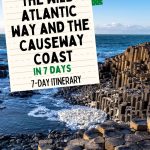Feeling a little overwhelmed planning your dream coastal exploration in Ireland? Worry not!
Utilising local knowledge, I’ve pieced together an amazing Causeway Coast and Wild Atlantic Way 7-day itinerary, specially crafted for you – the adventurous traveller ready to dive deep into Ireland’s natural allure.
This carefully curated journey whisks you from the majestic Causeway Coast through to the untamed beauty of the Wild Atlantic Way, revealing Ireland’s hidden treasures, iconic sights, and landmark sites in just seven days.
Let’s start this exciting journey together, shall we?
*This post contains affiliate links, which may include Amazon affiliate links. To read more about affiliate links, please visit my Disclosure Policy page.
What is the Causeway Coast?
To give its proper name, the Causeway Coastal Route is a 246km stretch of coastline that stretches from Belfast to Derry/Londonderry. It is studded with rugged clifftops, sandy beaches, fishing villages and one of Northern Ireland’s most popular tourist destinations. It connects Ireland’s Wild Atlantic Way to the Mourne Coastal Route.
Causeway Coastal Route with points of interest
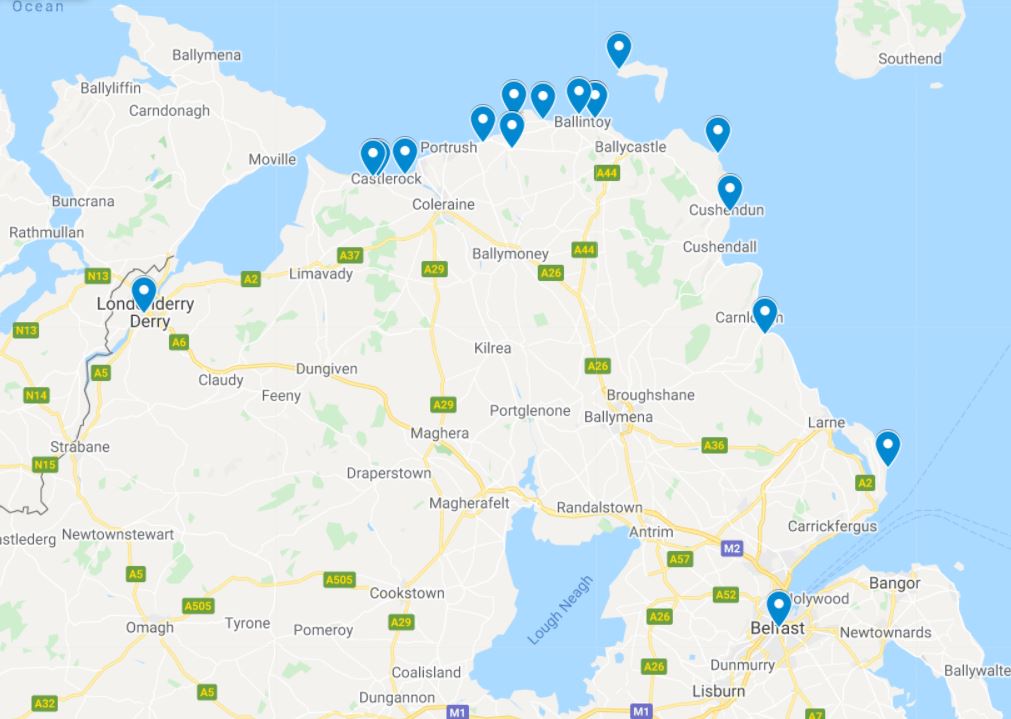
What is the Wild Atlantic Way?
The Wild Atlantic Way is a 2500km touring route which is also the world’s longest coastal driving route. It follows the west coast of Ireland from Malin Head in County Donegal in the north, to the Old Head of Kinsale in County Cork in the south.
You can read my comprehensive guide to the Wild Atlantic Way to find out more.
The Wild Atlantic Way map with points of interest
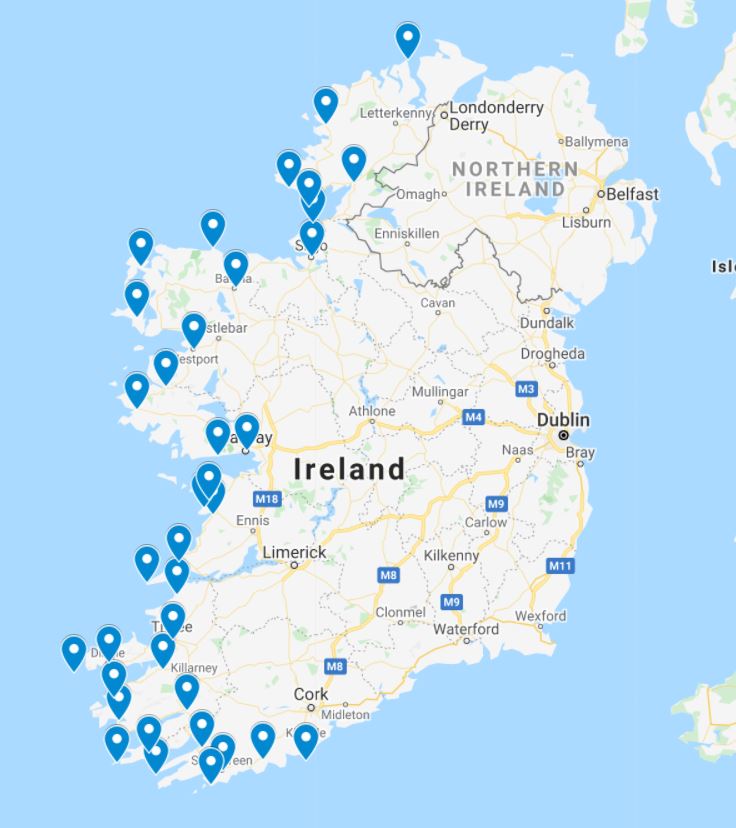
To discover how to see the best of the southern part of the Wild Atlantic Way, read my 5-day Wild Atlantic Way itinerary here.
How to get to the Causeway Coast and Wild Atlantic Way
To reach Ireland you will need to arrive by ferry or plane.
There are 3 main entry points for ferries to Ireland; Belfast, Dublin and Rosslare. Dublin or Belfast would be the best ports to arrive into as Belfast (the starting point for the itinerary below) is less than 2 hours from Dublin Port. You could also use Dublin to reach Limerick to start the itinerary in reverse. Limerick is approximately 2 hours and 15 minutes from Dublin Port.
Click here for routes and latest prices with Irish Ferries.
Click here for routes and latest prices with P&O Ferries.
Arriving by ferry in your own car gives you the freedom to explore these areas without the need to hire cars.
The other way to reach Ireland is by plane. There are four main airports in Ireland; Dublin, Cork, Shannon and Belfast. Dublin, Belfast or Shannon are the ideal ones to arrive into for this itinerary. We recommend checking Skyscanner for flights to Ireland.
- Dublin to Belfast – 158km, 1hr 40mins
- Dublin to Limerick (for doing this itinerary in reverse) – 202km, 2hr 15mins
- Shannon Airport – will leave you directly on the route to commence this Wild Atlantic Way and Causeway coast itinerary in reverse.
Arriving by plane, you will need to hire a car. We recommend checking prices on rentalcars.com. However, you MUST mention the fact that you will be crossing the border when booking your car hire. This is to ensure you have the correct insurance placed on the car. The Causeway Coast is located within Northern Ireland while the Wild Atlantic Way is located in the Republic of Ireland.
How to travel the Wild Atlantic Way and Causeway Coast
Driving the Wild Atlantic Way and Causeway Coast is the best way to enjoy these two routes in Ireland. Distances can be long between points so cycling the Wild Atlantic Way and Causeway Coast is not really feasible unless you are an experienced cyclist. Roads can be narrow without many overtaking points.
Roads are marked with Wild Atlantic Way signs so it is quite easy to navigate the route. Walking the Wild Atlantic Way in quieter, more remote parts can be an enjoyable way to explore the route but make sure to factor in time to your day if you want to walk or hike in certain areas.
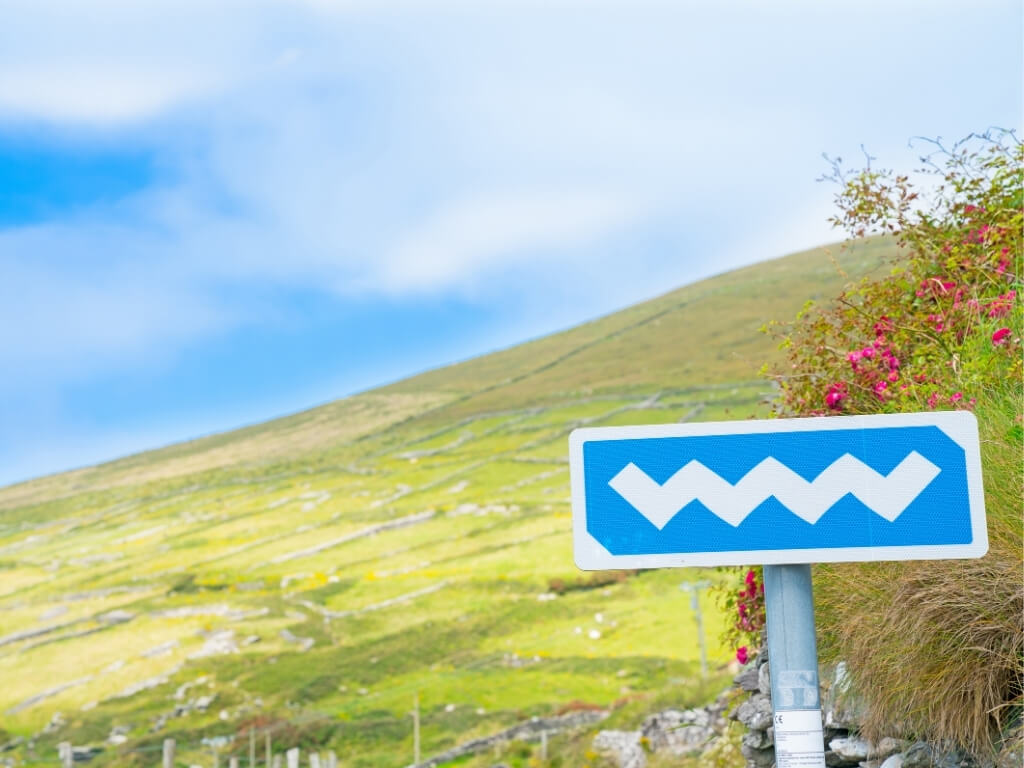
Where to stay along the Wild Atlantic Way
There is an abundance of places to stay along the Wild Atlantic Way and Causeway Coast from campsites, to B&B’s to hostels, hotels and luxury resorts.
While I will suggest places to stay for each overnight stop, you can always look for alternative accommodation via booking.com.
Why visit the Wild Atlantic Way and Causeway Coast?
Both of these places are areas of outstanding natural beauty in Ireland and are a must-see if visiting Ireland. From some of Ireland’s most popular tourist attractions to the history, culture, and cities and villages along the way, the Causeway Coast and Wild Atlantic Way are an Ireland road trip not-to-be-missed.
Best time to visit Ireland
The best time to visit Ireland’s Wild Atlantic Way is in the summertime. Days are long and you have a better chance of getting fine weather to enjoy a Wild Atlantic Way road trip. That’s not to say you shouldn’t pack waterproofs or an umbrella. Ireland can experience good and bad weather (and everything in between) even in the middle of summer.
However, if you want to avoid the crowds, consider going during Ireland’s shoulder seasons. The days are still long enough but the number of tourists is reduced compared to summer. As for winter, days are much shorter so you would need to factor this in but attractions and areas of interest will have few to little people.
To find out more about the best time to visit Ireland, read this post.
Discovering the Causeway Coast and Wild Atlantic Way in 7-Days
This Northern Ireland and Wild Atlantic Way Ireland road trip will take you through some of the most beautiful scenery on the island of Ireland and allow you to see some of the best highlights of the Wild Atlantic Way and also the Causeway Coast.
Each day has an estimated distance and driving time (without stops) to give you an idea of what to expect when moving from one place to another. You will need to factor in additional time for stops along the way.
Day 1 – Belfast to Derry
To begin exploring Ireland’s Wild Atlantic Way, you will need to make your way to Derry. On your first day of this Ireland road trip, you will be travelling from Belfast via the Causeway Coast to Derry/Londonderry. This route is approximately 180km long and will take 3hrs without stops at an average speed of 60kph.
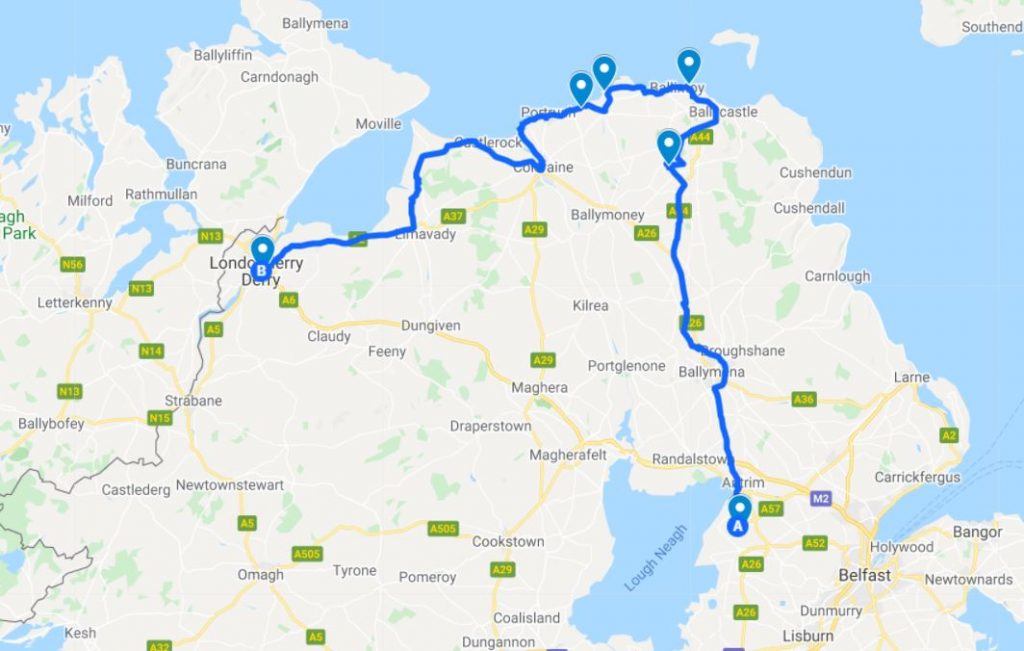
However, you will be stopping several times along this route before arriving in Derry/Londonderry, so get ready for a full day.
Northern Ireland’s north coast is a geological classroom and is home to Northern Ireland’s most popular tourist attraction, the Giant’s Causeway. Sea stacks, cliffs, caves, ruined castles and wooden glens are all found near or along the Causeway Coast. Between Belfast and Derry, you can also find filming locations for the TV series, Game of Thrones.
The Giant’s Causeway is said to have been built by an Irish Giant, Finn McCool, so that he could cross the sea to fight with the Scottish giant Benandonner. The Scottish giant pursued Finn McCool across the Causeway but took fright and fled back to Scotland, ripping up the bridge as he went. The Giant’s Causeway is all that remains of this bridge, with similar rock formations found on the island of Staffa in Scotland.
The truth is these are geological formations formed 60 million years ago when a thick layer of basaltic lava flowed along a valley in the existing chalk beds. With cooling, hardening and then erosion, the instantly recognisable hexagonal columns were formed.
But, the Giant’s Causeway won’t be your only stop along this Causeway Coast road trip. Here are other places to see and things to do on the Causeway Coast.
- The Dark Hedges, located near Ballymoney, are among the Northern Ireland highlights, thanks to their appearance as the Kingsroad on Game of Thrones. Have your camera ready and get there early.
- Carrick-a-Rede Rope Bridge is a must-visit in Northern Ireland and one of the best places to visit in Ireland. Swaying 30 metres above the waves and rocks, are you brave enough to cross it?
- The Giant’s Causeway is not to be missed.
- Dunluce Castle is located just 8km from the Giant’s Causeway and is a ruined castle located atop a dramatic sea cliff.
- The Old Bushmills Distillery is the world’s oldest licenced distillery and tours run throughout the day after which you can taste the world-famous whiskey.
- If you fancy stretching your legs, Portrush Beach is worth stopping at. A 3km stretch of sandy beach that ends at scenic chalks cliffs at Whiterocks, it is the perfect place for a stroll along the shore.
- At Downhill Demesne you will find the Mussenden Temple, another of the regions iconic buildings to feature in Game of Thrones.
- Explore the city walls of Derry/Londonderry before visiting some of the many museums and murals commemorating the events of Bloody Sunday in 1972.
Places to stay in Derry – For an affordable stay within the city walls, check into the Maldron Hotel. Click here for the latest prices and availability. Or for a more luxurious stay, stay in the Bishop’s Gate Hotel, a Grade B1 listed building found within the city walls at the Bishop’s Gate entrance to the city. Click here for prices and availability for this hotel.
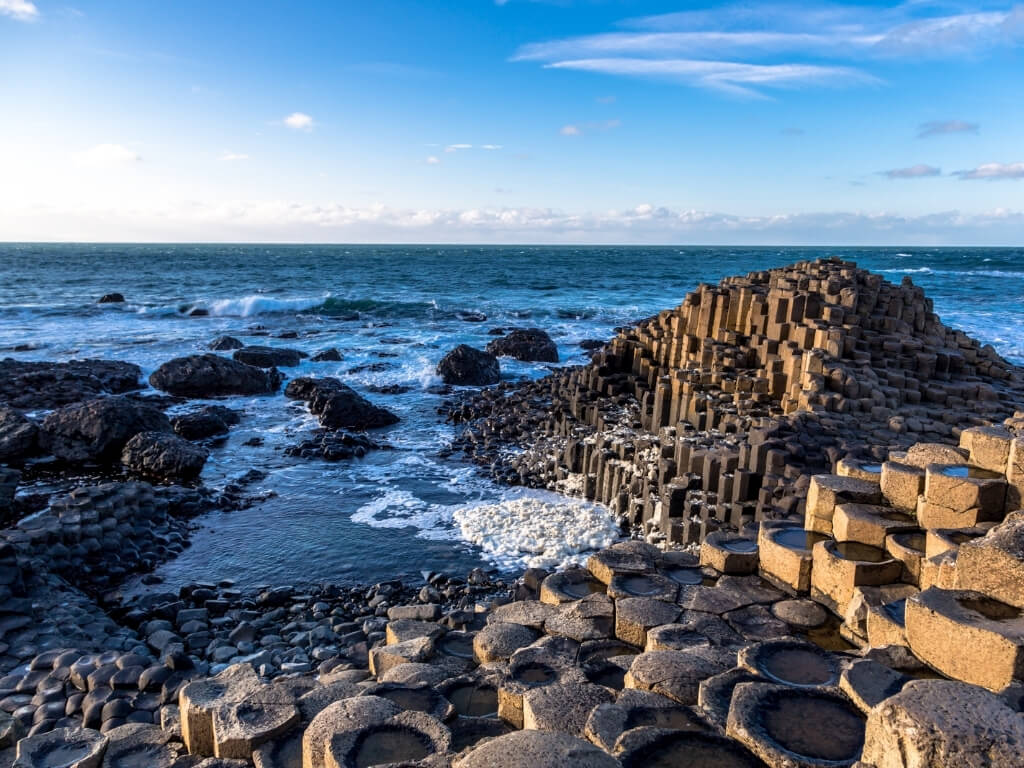
Day 2 – Derry to Dungloe
Today you will be starting your exploration of the Wild Atlantic Way. This section from Derry to Dungloe is around 291km long and will take approximately 5hrs and 30mins, without stops, at an average speed of under 55kph.
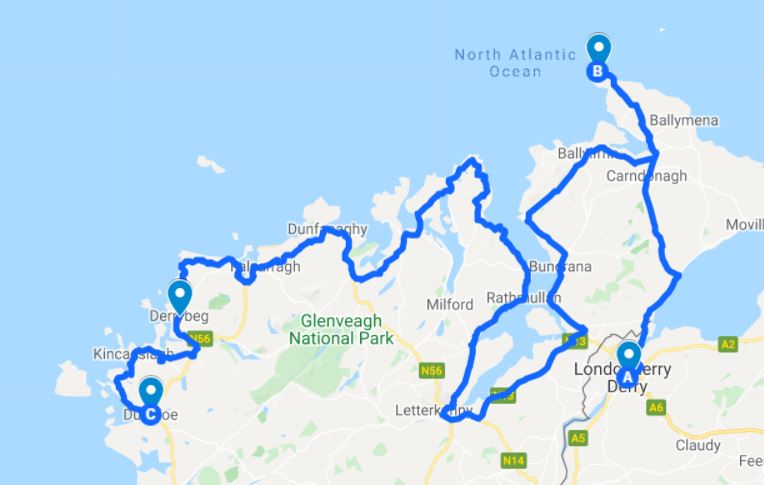
County Donegal fills the northwest corner of Ireland and is home to the northerly start/endpoint for the Wild Atlantic Way, Malin Head. Often overlooked by visitors, County Donegal is a gem in Ireland with spectacular scenery and a friendly welcome.
Upon departing Derry/Londonderry you will make your way to Malin Head, your starting point on the Donegal Wild Atlantic Way section, located on the Inishowen Peninsula. You’ll also be passing through the Fanad Peninsula before carrying on west along the coast. The Donegal coast is littered with lighthouses, sandy coves, and remote offshore islands.
A large part of this area is Gaeltacht, meaning Irish is the first spoken language. Things to do along the Donegal Coast include:
- Malin Head, the starting/end point for Ireland’s Wild Atlantic Way (as already mentioned).
- See the beautiful Glenevin Waterfall, near the Doagh famine village on the Malin Peninsula.
- The Fanad Lighthouse has warned passing ships since 1811. Although you cannot enter the lighthouse unless you are a guest staying there, you can photograph it from the small headland beside it.
- Visit the circular stone ring-fort of Grianan of Aileach, which is over 1000 years old and linked to the mythical Tuatha dé Danann.
- If you are visiting during summer, head to Horn Head to see if you can spot the breeding colonies of European shag, puffin and razorbill sea birds.
- Rosguill Peninsula has a particularly scenic route known as the Atlantic Drive with views to horn Head and Trá na Rosann Bay.
- Further west and then south, this section of the north Donegal coastline is famous for its beaches and the surf schools found at them. Some notable ones to visit are Marble Hill Strand, Killahoey, Machaire Uí Robhartaigh, Port Arthur Beach and Burtonport.
- If you prefer more wooded nature, the Glenveagh National Park found inland from the Wild Atlantic Way is a beautiful part of Ireland to visit.
Places to stay in Dungloe – for a budget-friendly option, stay at the Donegal Wild Atlantic Hostel, with both dormitory and private rooms available. Click here for prices and availability. Another option is the Radharc an Oileain B&B. See this accommodation choice here.
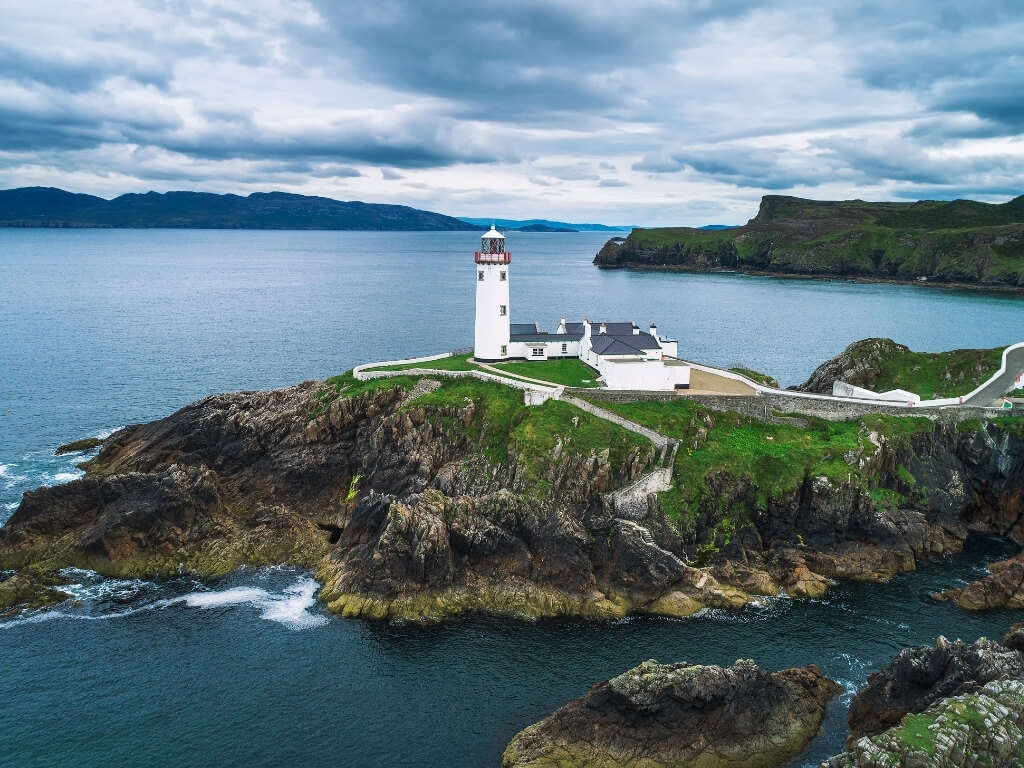
Day 3 – Dungloe to Donegal
On this section of your Causeway Coast and Wild Atlantic Way road trip, you will be departing Dungloe and heading to Donegal Town. Today’s drive is 111km long and will take approximately 2hrs and 10mins without stops at an average speed of under 55kph.
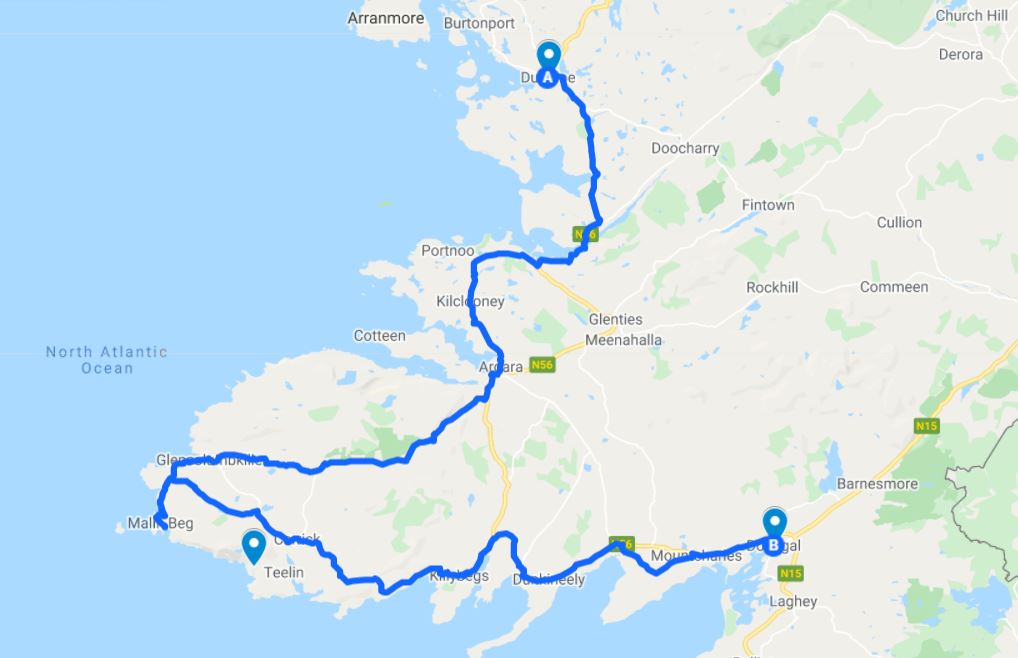
Low lying coastline, long sandy beaches and scenery which changes at every turn, this southern part of Donegal will see you pass green fields, vast beaches and eventually rocky hills and jagged coastline. Upon departing Dungloe, you will be heading south and then turning east as you follow the route of the Wild Atlantic Way. Much of today is about simply enjoying the landscape.
And no better place to do that than at the Slieve League cliffs. These lesser-known, yet spectacular, cliffs of the Irish Atlantic coast are one of the must-sees of the Wild Atlantic Way. The summit stands some 595 metres above sea level and slopes directly into the Atlantic Ocean. The best viewing point is at Bunglass but you could also see them from the water on a boat tour. The best time to see them is early afternoon or evening.
The Slieve League cliffs are one of a few things to do along this part of the Wild Atlantic Way.
- Photograph the sea arch at Crohy Head, located not too far from Dungloe.
- Enjoy a short walk in the tranquil Bonny Glen Wood.
- Visit the beaches of Dooey, Naran Strand, Maghera and Fintragh.
- See how life used to be in times gone by in the Glencolmcille Folk Village.
- Visit one of the few villages in Ireland that doesn’t have a pub, Malin Beg, located at the very tip of the Glencolmcille peninsula. There is a sheltered harbour and a watchtower from where you can enjoy views across to Rathlin O’Birne and down the Slieve League coastline.
- Another place for great views of Slieve League is the narrow headland of Saint John’s Point which also has a lighthouse and sandy beach.
- Explore Donegal town upon arrival or head out to see Lough Eske Castle (if you are not staying there, that is).
Places to stay in Donegal – For a budget-friendly stay, book The Gap Lodge B&B. See the latest prices and availability here. For a mid-range hotel, we recommend the Mill Park Hotel. Check prices and availability for this hotel here. Or for a luxurious stay, stay just outside Donegal Town in the stunning Lough Eske Castle. See this castle hotel, latest prices and availability here.
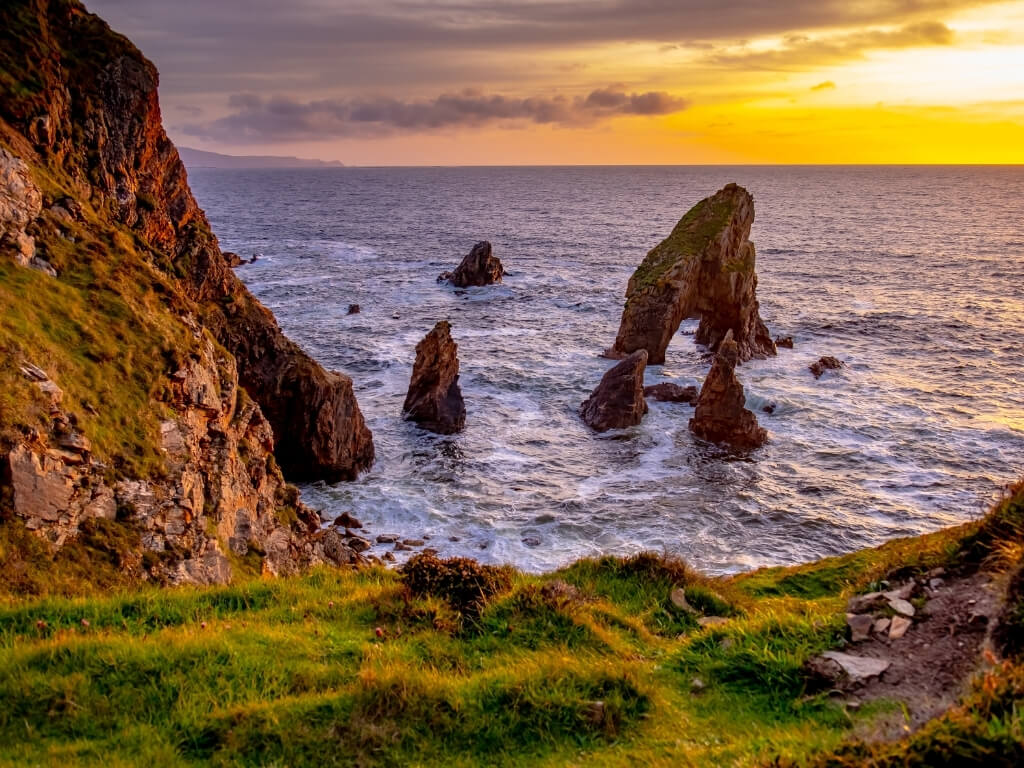
Day 4 – Donegal to Sligo
Your next destination on your road trip along the Wild Atlantic Way, Sligo is 102km from Donegal and this will take you approximately 2 hours without stops at a speed of under 55kph. While this section is quite short, you are most likely to make a few stops along the way.
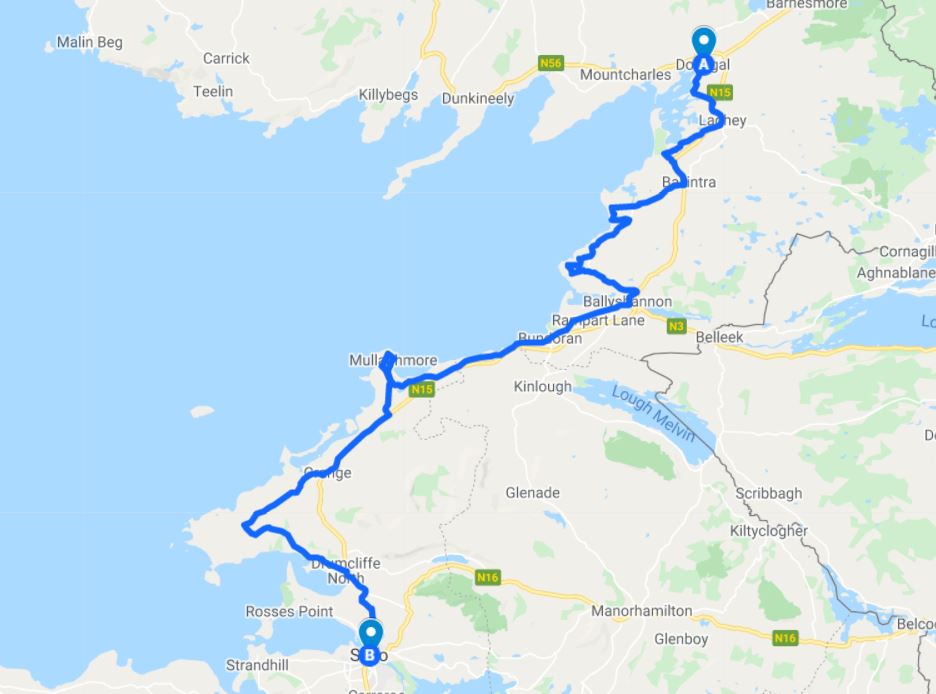
Upon departing Donegal you will be heading south past green fields that roll their way down to the shoreline. While Sligo town is your destination today, there are other notable places to visit in Sligo and Leitrim. However, you will need to detour slightly off the Wild Atlantic Way in order to visit them.
One of the places you need to detour off to visit is Benbulbin, one of the best things to see in Sligo. This mountain is an iconic Irish landmark with its signature flat summit and angular corners. Formed during the last Ice Age, Benbulbin is a must-visit in this part of Ireland and is best viewed from below.
The second place of interest lies inside County Leitrim and that is the Glencar Waterfall. Hidden in an area also known as the Swiss Valley, this beautiful waterfall in Ireland is only a short walk from the car park through lush woodland.
Other things to see and do along this section of your Wild Atlantic Way trip are:
- The seaside town of Bundoran has been a holiday destination with native Irish families for decades and is home to one of the best beaches. Enjoy a walk along the Main Beach, Tullan Strand or the Rougey Walk, on which you should look out for the Fairy Bridges (sea arches) and the Wishing Chair along the way.
- Stop at the small seaside town of Mullaghmore, whose international reputation for producing some of the biggest waves in the world cause surfers to flock to this tiny town in Ireland. There is a pretty walk on the headland where you can enjoy views of Classiebawn Castle.
- Visit the childhood home of Constance Markievicz, one of the ring leaders of the 1916 rising and first woman elected to the British House of Commons, Lissadell House.
- Climb Knocknarea to visit Meabh’s Cairn and, on a good day, enjoy spectacular views as far as Benbulbin, Lough Gill and even Slieve League.
- Watch the surfers in action at Strandhill, a seaside village on whose beach it is strictly forbidden to swim due to the dangerous currents and rip tides. But grab a cuppa in one of the coffee shops and watch the surfers ride the waves.
Places to stay in Sligo – for a comfortable, budget-friendly stay, check into the Clayton Hotel. Check prices and availability for this hotel here. Or consider the more mid-range Radisson Blu Hotel & Spa. See this hotel and the latest prices here. Both hotels have a pool.
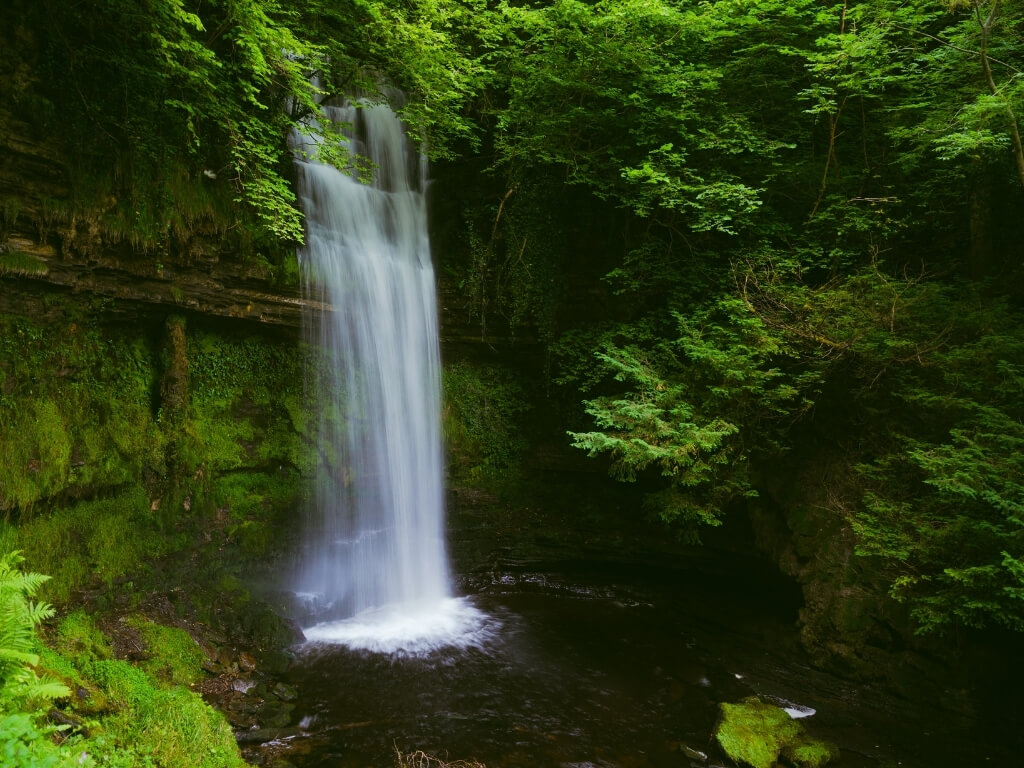
Day 5 – Sligo to Westport (via Achill)
After two relatively easy driving days, you have got some long ones ahead. From Sligo, you will be heading to Westport via Achill Island today. This drive is 312km long and will take approximately 5hrs and 10mins at an average speed of 60kph.
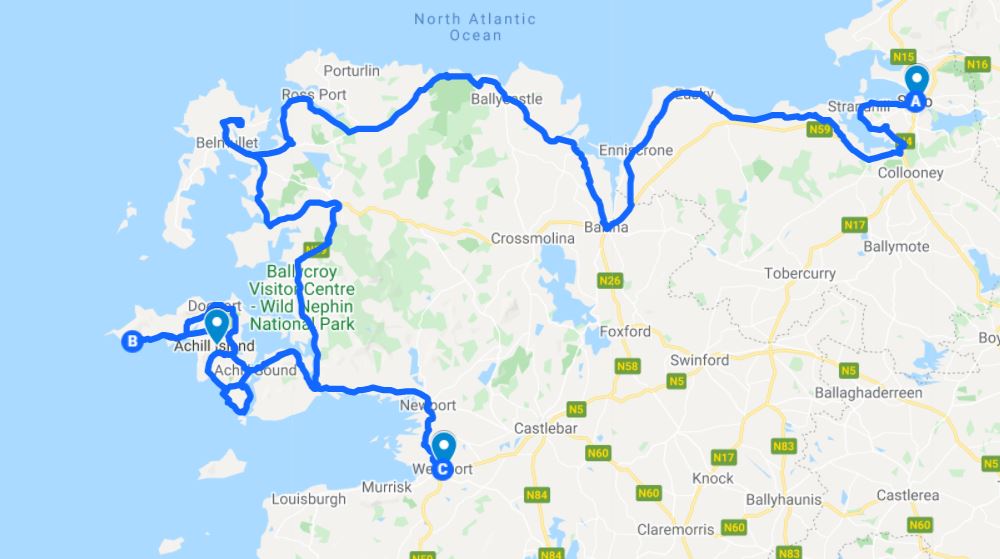
Driving west from Sligo, you will be following the rugged coastline as you leave County Sligo and enter County Mayo, one of the prettiest counties in Ireland in my opinion. Mayo is dotted with beautiful beaches, craggy islands, Ireland’s holiest mountain and is home to Ireland’s largest island.
This area of Ireland is one of the least densely populated but is also one of the most beautiful. Intertwined with nature are historical sites to visit and sculpture trails to seek out.
The best things to do in Mayo along this section of the Wild Atlantic Way are:
- Ireland’s most extensive prehistoric cemeteries are located just south of Sligo. Carrowmore is the largest group of megaliths in Ireland and the second largest in Europe.
- Find the outdoor sculpture trails of Tír Sáile and Spirit of the Place. There are more than 20 scattered along the coast in north Mayo.
- Wander through a 1,000-acre forest at Belleek, just north of Ballina, before passing by Belleek Castle.
- See the spectacular sea stack of Dún Briste and nearby blow-holes at Downpatrick Head.
- Mayo is home to the world’s most extensive Stone Age monument, the Céide Fields. These are field systems, megalithic tombs and dwelling areas and you can learn more at the visitor’s centre.
- Ballycroy National Park is 11,000 hectares of mountain and bog and is home to one of the last intact active blanket bog systems in Western Europe. There is a visitor’s centre to learn more about the region.
- Cross the small bridge from mainland Ireland onto its largest island, Achill Island and head to Keem Beach. Stop at the viewing point on the side of the hill above the beach and see if you can spot basking sharks in the bay if visiting in Spring and Summer.
Places to stay in Westport – If you are looking for a budget-friendly option for accommodation in Westport, we recommend the Wyatt Hotel. Click here for the latest prices and availability. If it is luxury you want, consider booking into the Westport Plaza hotel. Find out more and see the latest prices here.
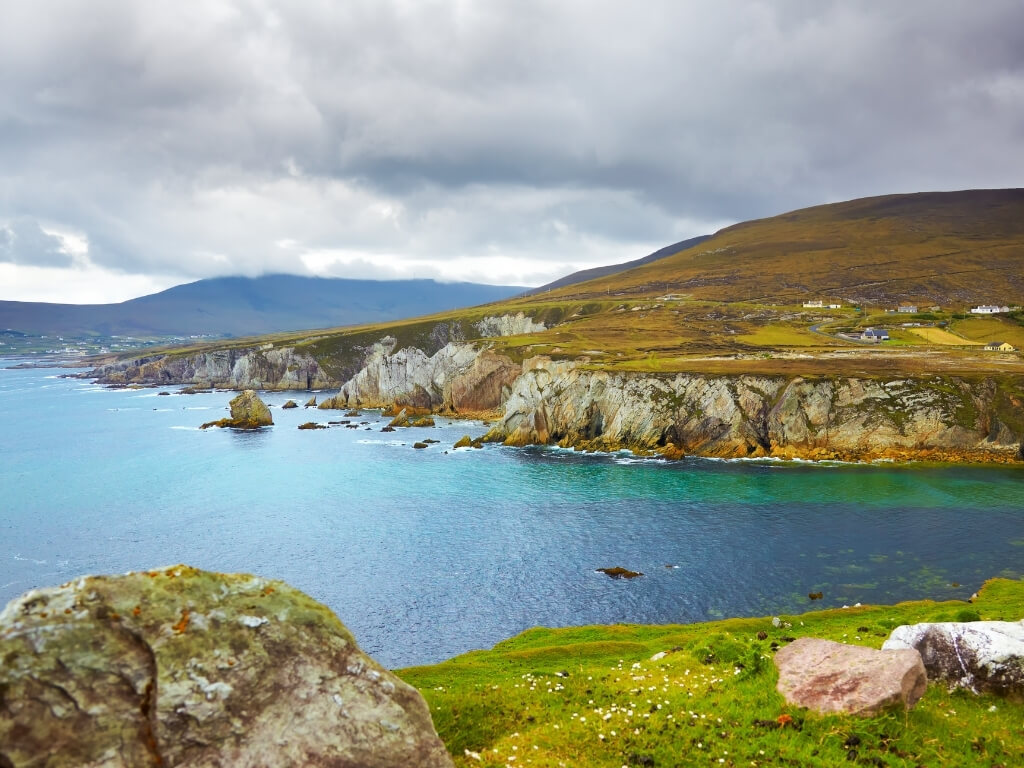
Day 6 – Westport to Galway (Via Connemara)
Today you will be travelling through the rest of Mayo and onto Galway City. This section of your Wild Atlantic Way itinerary is 238km long and will take approximately 4hrs 45mins without stops at an average speed of 55kph.
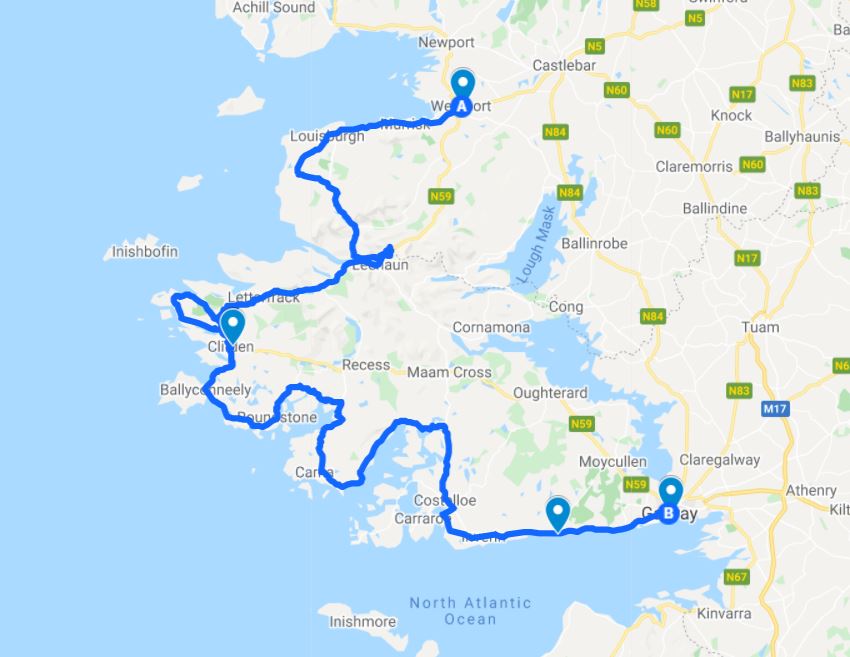
From Westport, you will be travelling south and then east to Galway via southern Mayo, the Connemara National Park and the low-lying coastline of southern Galway. The area between the land and the sea is easily accessible and with a predominantly flat terrain near the coast in southern Galway, if you fancy a bit of biking, this is the ideal area for it.
Upon leaving Westport you can visit Ireland’s holiest mountain, Croagh Patrick. Its summit lies at 764m and the tradition of making the pilgrimage to the summit dates back over 5000 years. The mountain takes its name from Saint Patrick who is said to have fasted at the summit for 40 days. If you plan to make this pilgrimage, add a day to this itinerary as it is a 7km hike from sea level to the summit.
Once you pass into County Galway you will come across the beautiful Connemara National Park. Much of Galway’s coastline lies within it and it is one of the most popular tourist areas of Ireland.
The best things to do in Mayo and best things to do in Connemara along this stretch of the route include:
- Visit the Old Head Nature Reserve just behind at beach at Old Head.
- Enjoy a walk along the shores of Carrownisky, Cross, White or Silver Strand.
- See the roadside memorial to those who died during the Famine at the Doo Lough Famine Memorial.
- Have a picnic beside Aasleagh Falls, a small but beautiful waterfall just north of Leenane.
- Wonder at the beauty of Kylemore Abbey near Letterfrack, or enter Connemara National Park from there for a detour drive.
- Stop for lunch in the bustling little town of Clifden, the unofficial capital of Connemara.
- See where the first transatlantic flight landed near Derrigimlagh. The site of the first transatlantic wireless message was sent from the Telegraph Station near Derrigimlagh.
- Completely devoid of trees, see the vast Roundstone Bog which despite seeming barren and lifeless is home to a wide range of wildlife including purple moor grass, wildflowers and even lizards.
- If you are visiting during the first weekend in August, try to time your trip with the maritime festival held in Carraroe, called the Féile an Dóilín. Maritime races, parades and boat-making feature.
- Stretch your legs with a walk along Salthill Promenade before finishing your day in Galway City itself.
Places to stay in Galway – A great budget-friendly place to stay in Galway is the Jury’s Inn Galway Hotel. Click here for the latest prices and availability. If you want to be in the centre of Galway, there is no better place to stay than The Hardiman on Eyre Square. See this hotel and its prices and availability here. And finally, if it is luxury you want, check into the G hotel, a short 20-minute walk from Eyre Square. Check the latest prices and availability here.
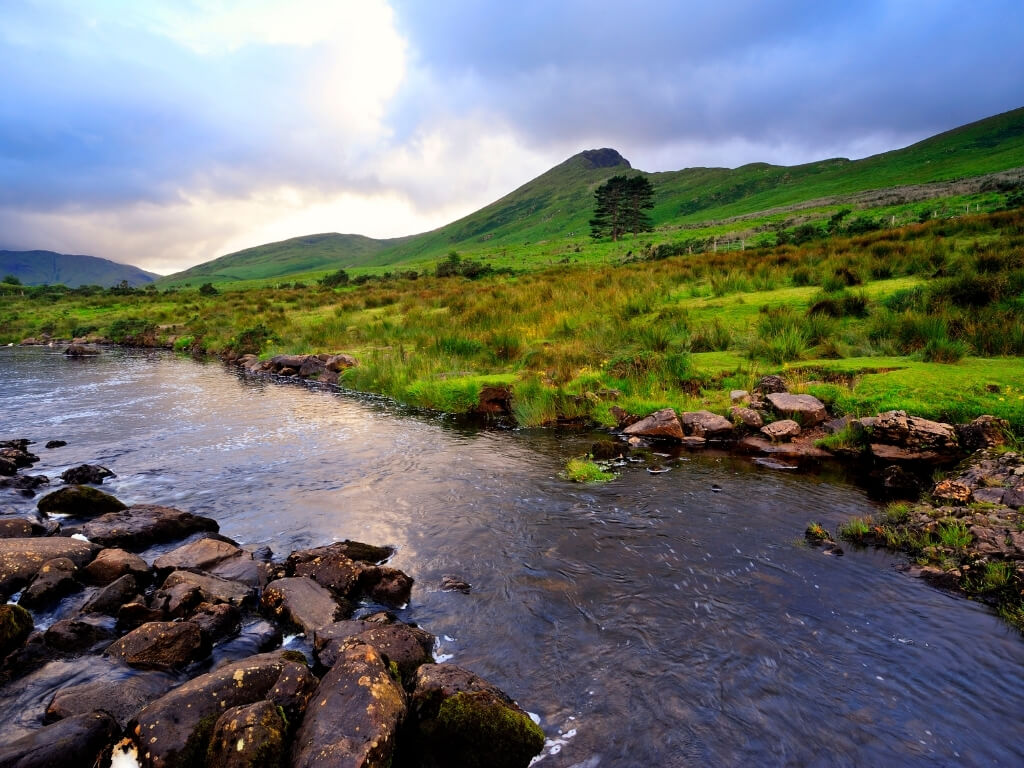
Day 7 – Galway to Limerick (via the Cliffs of Moher)
On your last day, you’ll be heading south from Galway to Limerick. This last stretch of your Wild Atlantic Way road trip itinerary is 275km long and will take approximately 5hrs 15mins with no stops at an average speed of 55kph.
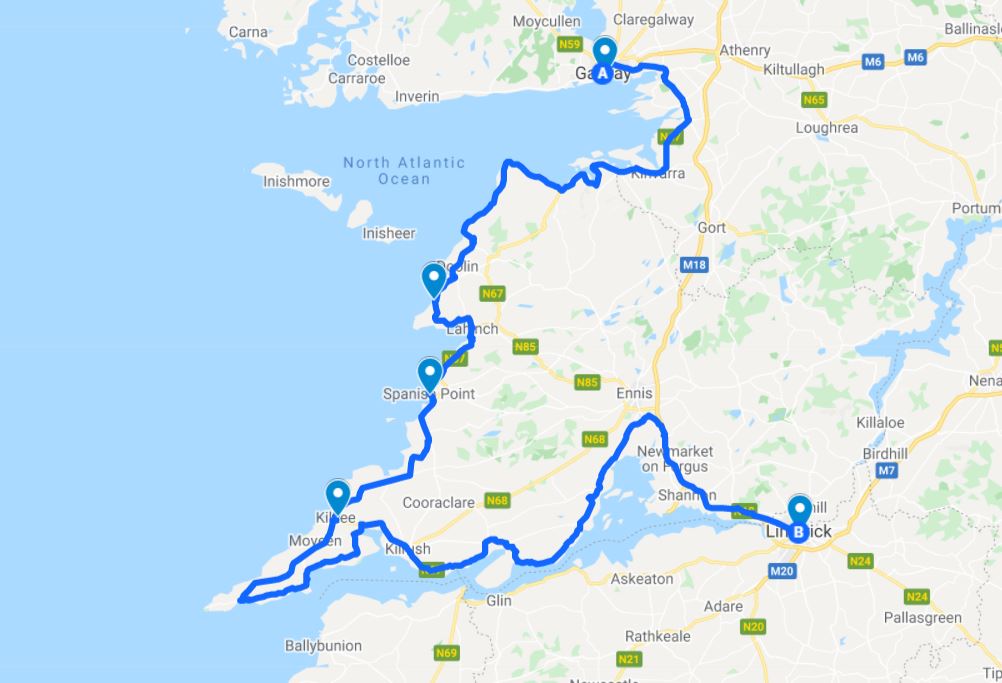
After leaving Galway, you will be following the coast that will lead you to one of the most popular tourist destinations in Ireland, the Cliffs of Moher. Located in County Clare, these sea cliffs are quite spectacular, stretching for 8km and reaching heights of 214m. Views in all directions do not disappoint. There is a visitor’s centre with interactive displays where you can learn more about the flora, fauna and geology of the cliffs. And O’Brien’s Tower is also a great viewing point. No trip to the Wild Atlantic Way would be complete without a visit to the world-famous Cliffs of Moher.
But the Cliffs are not the only top thing to do in Clare along the Wild Atlantic Way Route.
- The 16th-century tower house of Dunguaire Castle near the town of Kinvara is worth stopping at.
- Along this route, you could also detour to the Burren National Park, Ireland’s smallest but no less beautiful national park. The landscape is very distinctive.
- Doolin is a great town to stop in for refreshments before you visit the Cliffs of Moher. While you are there, why not pay a visit to the Doolin Cave, home to the largest known stalactite in the Northern Hemisphere.
- If you don’t refuel in Doolin, Lahinch is another good bustling town with cafes, pubs and restaurants for refreshments. After lunch, stretch your legs with a walk along the 2km golden sandy beach.
- Another ruined castle to make a quick stop at along this route is Doonbeg Castle.
- The cliffs at Kilkee are well worth a look and are no less impressive than their northern cousins in the county of Clare.
- Loop Head Peninsula is a lovely corner of Clare and the cliffs where the lighthouse is located are worth seeing. Nearby the Bridges of Ross are also worth visiting, although there now remains only one intact.
Places to stay in Limerick – For a comfortable and budget-friendly stay in Limerick, check into The George Hotel. See this hotel and the latest prices and availability here. For a luxury stay, choose the Radisson Blu Hotel in Limerick. Click here to view this hotel and see the latest prices and availability.
Alternative route: If you don’t wish to visit Loop Head or if you are short on time after visiting the Cliffs of Moher, you can skip the Loop Head Peninsula and head straight towards Limerick via Ennis. This alternative route is 169km long, including the coast from Galway to Lahinch, and will take approximately 3 hours at an average speed of under 60kph.
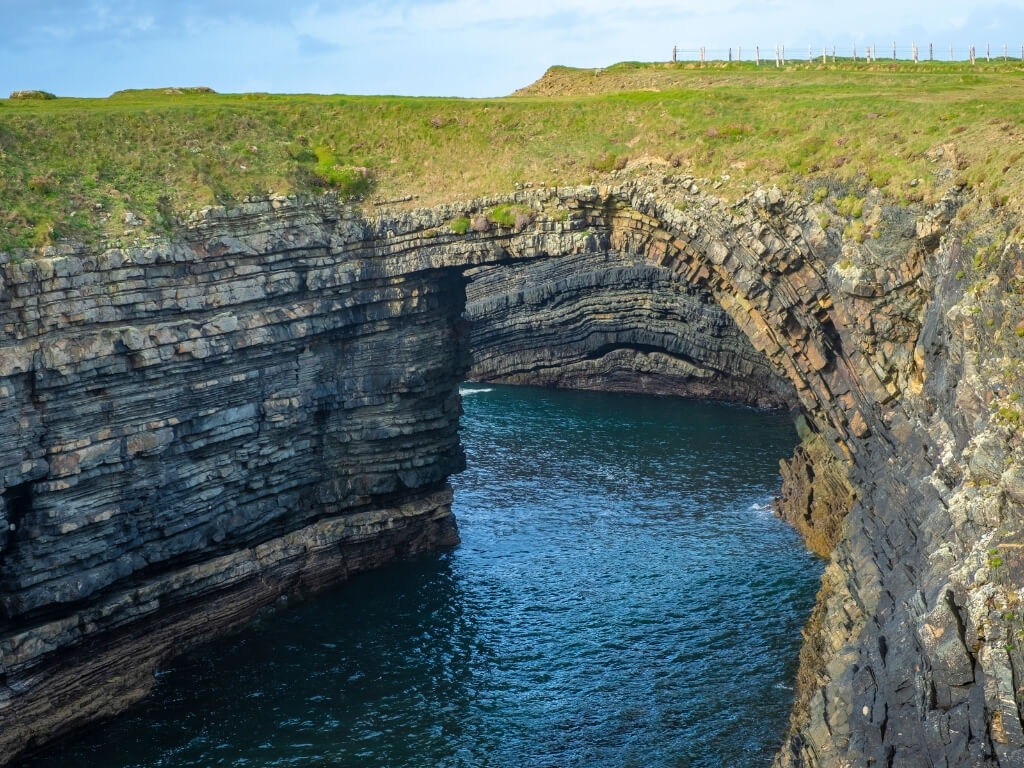
Another great place to stay to end this trip is the Bunratty Castle Hotel, a short 20-minute drive from Limerick along the road you will be travelling on. Bunratty Castle is located across the road from the hotel and Bunratty Castle and Folk Park is worth visiting the following day if you have time. If you do decide to stay at Bunratty Castle (check prices and availability here), enquire about tickets for the Medieval Banquet held in the castle every night. It would be a great way to end this Causeway Coast and Wild Atlantic Way road trip.
Other things to note and tips for visiting the Wild Atlantic Way
Now that I’ve shown you the best way to see both the Causeway Coast and Wild Atlantic Way in 7 days, here are some other things to note before making this trip.
Wild Atlantic Way discovery points
There are over 160 official discovery points along the Wild Atlantic Way, and 15 of them have been designated signature discovery points. They are
- Malin Head, Donegal
- Fanad Head, Donegal
- Slieve League, Donegal
- Mullaghmore Head, Sligo
- Downpatrick Head, Sligo
- Keem Strand, Mayo
- Killary Harbour, Galway
- Derrigimlagh, Galway
- Cliffs of Moher, Clare
- Loop Head, Clare
- Blasket’s View, Kerry
- Skellig’s view, Kerry
- Dursey Island, Cork
- Mizen Head, Cork
- Old Head of Kinsale, Cork
The discovery points signify the best places to see along the Wild Atlantic Way.
Wild Atlantic Way passport
The Wild Atlantic Way discovery points each have a unique ink stamp which can be collected in a commemorative book called the Wild Atlantic Way passport which is available from An Post or at An Post post offices along the route. The stamps can be collected at dedicated post offices along the Wild Atlantic Way or in certain tourist offices in the bigger towns along the route. This is a great way to collect the memories from your trip. Find out more here.
Hiking the Wild Atlantic Way
There are endless walks, trails and hikes along the Wild Atlantic Way and if you want to do a few, make sure to incorporate enough time into this itinerary to allow for it. Ensure you stick to trails that are within your ability level and make sure you have the appropriate footwear. A damp climate and soft ground can make paths muddy, wet and slippery.
Also ensure that you bring layers with you, even in summer, as you never know what type of weather you will encounter. Make sure you pack water and a portable battery charger for your phone, just in case.
Ensure you respect signs on private or farmland. Close gates behind you as much of the area along the Wild Atlantic Way is farming land with sheep and cows in abundance. For marked trails, the Irish Trails website is a brilliant resource.
Final thoughts on exploring the Causeway Coast and Wild Atlantic Way in 7 days
The Causeway Coast and Wild Atlantic Way are two areas of Ireland which everyone should visit at least once. With this 7-day Ireland itinerary, you can visit both and cover all the major tourist attractions and some great cities along the way. For more information or more help planning a trip along the West coast of Ireland, I recommend this Wild Atlantic Way guide book.
More about visiting and exploring Ireland:
- A Complete Guide to the Wild Atlantic Way
- See the Best of the Wild Atlantic Way in 5 Days
- Natural Wonders of Ireland You Cannot Miss
- Best Beaches in Ireland
- National Parks of Ireland
- Best Time to Visit Ireland
- How to Get Around Ireland
- What to Pack for Ireland
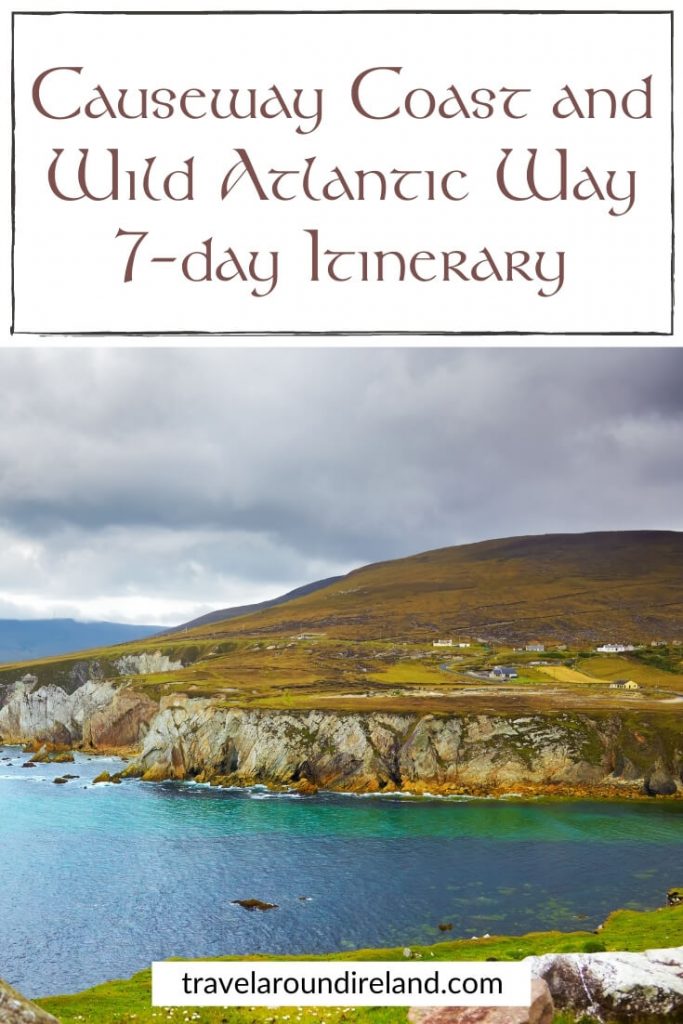
Travel Around Ireland is a participant in the Amazon Services LLC Associates Program, an affiliate advertising program designed to provide a means for sites to earn advertising fees by advertising and linking to amazon.com, amazon.co.uk, amazon.ca. Amazon and the Amazon logo are trademarks of Amazon.com, Inc. or its affiliates. To learn more about affiliate links, read my Disclosure Policy here.

